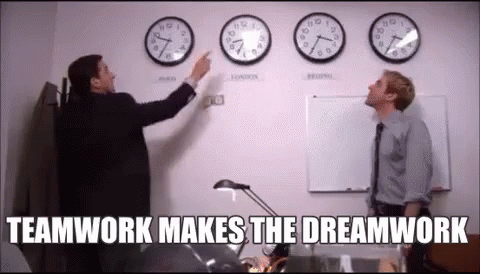Have you ever struggled with group participation or felt more productive working independently?
Perhaps you’re a team player at heart, but feel taxed, even lost, when collaborating in a joint setting.
If so, I want to encourage you: a) you’re not alone and b) dare to rethink what you know about teamwork.
For while corporate success often hinges on team dynamic (i.e. how a group behaves and performs in pursuing a particular goal), such cooperation is only possible when each member knows the purpose and direction of their role.
Thus, in the next few posts, I want to discuss how we, as students and employees, can build teamwork through better team dynamic starting with these three points…

1) Clarify Expectations
It’s been said group morale is a fragile art – a sacred science based on strength integration, maintaining transparency, and trust management.
Yet, of all the bonds that bind, arguably none is more cohesive to team dynamic than clarifying expectations.
To quote Ron Edmondson…
“to feel a part of the team, people need to know where the team is going and what their role is. An understanding of the overall goals and objectives fuels energy. When the big picture objective is understood each team member is more willing to pull together to accomplish the mission because they know the ‘why’ and can better understand where they fit on the team.”
In other words, to achieve positive outcomes, each role must be clearly defined in a way direction, unity, and purpose are mutually inclusive. Of course, none of this can happen without accountability, authenticity, and strategy/tactics (as we’ll later discuss); however, as long as expectations are effectively communicated top-to-bottom, the foundation to success is, at least, secured.
Bottom line: The more people perceive core value and expectations1 through vision, the more team dynamic will strengthen.

2) Don’t Just Direct People, Develop Them
As mentioned in my ‘effective influencer’ post, strong teams form when people are valued over goals and success is celebrated corporately as well as individually.
Unfortunately, not all work cultures are created equal where motivation is shared, let alone contagious. The question is…
How do we inspire unity among our teams regardless of setting, situation, or position?
For starters, we must be willing to connect role to direction and expectation to vision. In my case, having worked in various financial and ministerial arenas, I’ve found the best unity occurs in environments where each member understands their role and how it directly impacts the success of the organization.
Granted, easier said than done for the sanitation engineer and mail deliverer; still, if strong team dynamics are applied, even these employees can be directed to know the company’s core values2 and developed to take ownership of their responsibility.
Ultimately, if team members are empowered to see their skin in the game, camaraderie will flourish in the sense each person is directed, developed, and driven to see his/her work as more than a means to an end.
Bottom line: Intentional leaders not only give their team intentional purpose, but help their teams understand mission while embracing vision.

3) Get Out of the Office
A great ministry leader once said…
“Don’t get so busy doing the work of the Lord that you don’t spend time with the Lord of the work.”
Interestingly, while this truth pertains to spiritual intimacy, the same concept can be applied in collaboration and networking. After all, if project management and people management are best undivided, then the quality of our communication should extend beyond performance into its surrounding context.
For example, as a former LAMPO spouse, sports editor, and youth pastor, no question, the best “silo-busting” moments occurred during retreats, corporate team-building activities, and family outings. In each scenario, not only were tensions lessened, but a sense of esprit de corps developed carrying over into seasons of challenge and discomfort.
Moreover, to the extent creativity and oasis conversations abounded, to that extent priorities were pruned in the wake of internal and external inventory. Ultimately, as awareness within community increased, so did morale and enthusiasm by proxy.
Bottom line: 1) Teamwork is just as much attitude as it is practice. 2) If you want better teamwork, know the context of your team’s performance given team dynamic is influenced just as much outside work as at work.
Selah.

Looking ahead, I want to talk about how we, as spouses and household heads, can abide by the same teaming principles outside our careers and inside our homes.
In the meantime, be at peace as you better people to better your teams to better your business.
As always, Lys & I are rooting for you.
Here’s to the journey…
~ Cameron
Footnotes
- Even compensation
- Tip: consider creating a team charter)
Cover photo creds: Australian Institute of Business







